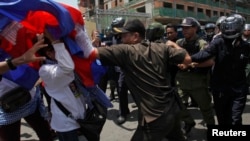Experts warn that Cambodia still faces the prospect of violence and atrocities, as human rights abuse and other social injustices persist.
But Cambodia’s leaders still have the “responsibility to protect” the country’s citizens, according to standards issued by the UN.
The “responsibility to protect” was a norm acknowledged by international heads of state at the UN in 2005, in an effort to end genocide, war crimes, ethnic cleansing and other atrocity crimes. It is not a law, but a political agreement to guide states and their agreements with each other.
At a meeting to discuss that responsibility in Bangkok recently, experts said that while Cambodia does enjoy peace, it lacks many of the foundations of stability.
One tool to help with that is the “Framework of Analysis for Atrocity Crimes,” which evaluates 14 factors that can put a country at risk. These include the lack of an impartial judiciary, high levels of corruption, poor governance, human rights abuses and impunity: factors that put Cambodia at risk.
Pou Sothirak, executive director of Cambodian Institute for Cooperation and Peace, told VOA Khmer at the sidelines of the “Responsibility to Protect” workshop in Bangkok last month that Cambodia’s land disputes are a specific risk.
“Although the Khmer Rouge was toppled and its leaders are on trial, there are other signs that could become a risk factor if we don’t pay attention to them,” he said. “For instance, the lack of attention on land issues, which is not satisfied by many people, could cause social insecurity and possibly spark demonstrations, leading to violence in society.”
The lack of good governance and transparency in regards to natural resource exploitation, along with the wealth gap between the rich and the poor, can be risk factors, as well, he said.
“Actually the government is trying to maintain political stability in order to obtain social security and economic growth,” he said. “However, poverty and the wealth gap between the rich and the poor in Cambodia still exist. Thus, the government should strive for more improvement in order to avoid social crisis, in which more and more people become poor and cause trouble for the society. So poverty can also be a risk factor.”
The threat of the Khmer Rouge has been extinguished, and Cambodia now has peace, but that does not mean there is no violence or intimidation.
Kimsour Phirith, a lawmaker for the opposition Cambodia National Rescue Party who attended the Bangkok workshop, said that Cambodia still faces the risk of political violence. He pointed to the recent beating of two lawmakers outside the National Assembly, following anti-opposition protests, as evidence.
“If the international community does not focus on pushing the government back on the path of respect for human rights and democratic foundations, we could fall back onto the path towards atrocity in the future,” he said. “Particularly, the prime minister often uses rhetoric through the public media, [saying] that if the Cambodian People’s Party loses the elections, there will be war. We are concerned that this kind of language would encourage violence in our society.”
Prime Minister Hun Sen often makes such warnings, recently conjuring the 2008 border conflict with Thailand as just one example, saying that conflict would have led to war had the opposition been in power. “If another party came to power, war would definitely occur,” he said in one such speech. The Rescue Party, he said, treats the rich as an enemy, as well as neighboring countries.
That kind of rhetoric can create the risk of more violence, according to the Framework of Analysis for Atrocity Crimes. Political motives, particularly those aimed at the attainment or consolidation of power or acts of incitement or hate targeting particular groups or individuals create such a risk, according to the framework.
CPP spokesman Sok Eysan told VOA Khmer such warnings from the prime minister are political realities, based on the policies of the Rescue Party. He warned that the party would “obliterate investment agreements and seize the properties of the rich and give them to the poor.”
“So it is clear that war would take place,” he said. “Are the rich just easily willing to give up what they have for the poor?”
The UN framework, meanwhile, has prescriptions for curbing violence and atrocity crimes.
“Prevention is an ongoing process that requires sustained efforts to build the resilience of societies to atrocity crimes by ensuring that the rule of law is respected and that all human rights are protected, without discrimination; by establishing legitimate and accountable national institutions; by eliminating corruption; by managing diversity constructively; and by supporting a strong and diverse civil society and a pluralistic media,” it says. “Failure by the state to provide such protection and guarantees to its population can create an environment conducive to atrocity crimes. In such cases, prevention involves efforts to halt a likely course of events.”
Noel Morada, director of the Asia Pacific Center for the Responsibility to Protect, said at the workshop in Bangkok that each state needs prevention measures in place to prevent atrocities and violence. In other words, they should not wait for an outbreak of violence and then turn to the UN for help.
“Don’t forget that there are many crises around the world,” he said. “The funding of the UN is so limited, even in terms of peacekeeping, [so] prevention and response on the ground will depend a lot on those people who are there and educators, civil society people, and government. They need to engage in national dialogue and discuss, identify the risk factors in order to prevent. I think the long term view when it comes to implementing [responsibility to protect] is the building of capacity, and the stakeholders need to work on this together.”






